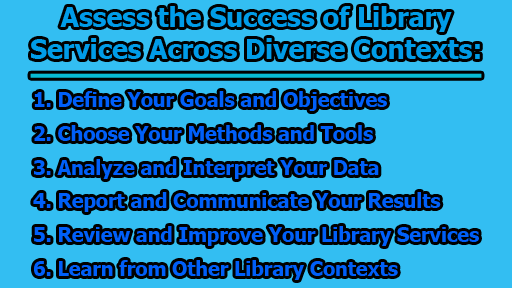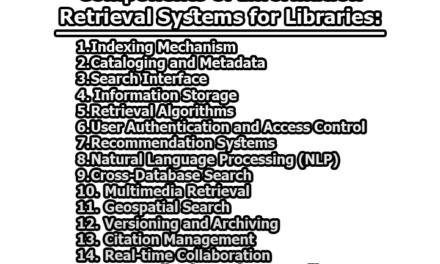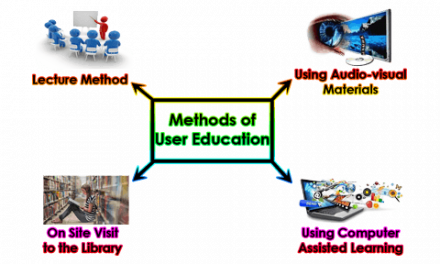Assess the Success of Library Services Across Diverse Contexts:
Library services play a pivotal role in providing access to information, education, culture, and community. They serve as vital hubs for learning, research, and community engagement. However, to gauge their effectiveness and impact, it’s crucial to measure the success of library services in various contexts. Whether you’re a librarian, a library user, a funder, or an advocate, understanding how to evaluate library services in different settings and scenarios is essential. In this article, we will delve into the methods and tools that can help you assess the success of library services across diverse contexts.
1. Define Your Goals and Objectives: The first step in measuring the success of library services is to clearly define your goals and objectives. What are you aiming to achieve with your library services? Who are your target audiences and stakeholders? It’s essential to align your library services with your mission, vision, and values. Communicating these goals and objectives to your staff, users, and partners is crucial to ensure everyone is on the same page. By defining your goals, you can establish realistic expectations, identify key performance indicators, and plan your evaluation strategy effectively.
2. Choose Your Methods and Tools: To measure the success of library services, selecting the appropriate methods and tools is essential. Depending on your goals and objectives, you can use a variety of approaches, such as surveys, interviews, focus groups, feedback forms, statistics, metrics, reports, observations, assessments, tests, stories, testimonials, and case studies to collect and analyze data. For instance, surveys are valuable for gathering both qualitative and quantitative data on user satisfaction and feedback, while statistics and metrics can quantify service usage and circulation. Observations and assessments can help measure behaviors and skills, while stories and case studies can illustrate the impact of your library services. Various software platforms and techniques are available to assist in collecting and presenting this data in different formats.
3. Analyze and Interpret Your Data: The third step in measuring the success of library services involves analyzing and interpreting the collected data. This includes processing, organizing, summarizing, and synthesizing the data to draw meaningful conclusions and insights about your library services. Various methods and tools can be employed for this purpose, such as descriptive statistics for basic data features, inferential statistics for testing hypotheses, content analysis for qualitative data, and SWOT analysis to understand strengths, weaknesses, opportunities, and threats. These insights help in assessing the effectiveness and impact of your library services.
4. Report and Communicate Your Results: After analyzing the data, it’s essential to report and communicate your findings and recommendations effectively. Visual aids like charts, graphs, tables, and infographics can be used to present data, highlighting trends, comparisons, proportions, and relationships. Narratives, stories, and testimonials humanize and personalize the value and benefits of your library services. Reports, presentations, and publications help document and disseminate your evaluation methods, results, conclusions, and recommendations. Additionally, webinars, workshops, and events can facilitate engagement and interaction with stakeholders for feedback, discussion, and collaboration on library services evaluation.
5. Review and Improve Your Library Services: The fifth step in measuring the success of library services is to use evaluation results to inform decision-making and action planning. Employ methods like SMART goals for setting specific, measurable, achievable, relevant, and time-bound objectives, action plans to outline steps, tasks, resources, responsibilities, and timelines, feedback loops to monitor and adjust based on user feedback, and continuous learning to stay updated with the latest trends in library services evaluation and improvement. This continuous improvement cycle ensures that library services stay relevant and effective.
6. Learn from Other Library Contexts: Lastly, learning from other library contexts can provide valuable insights. Benchmarking allows you to compare your library’s performance with other libraries that have established standards or best practices. Peer review fosters feedback exchange with libraries that have similar or different evaluation experiences and challenges. Networking helps build relationships with libraries sharing similar interests and goals. Collaboration can be an avenue for partnering with other libraries that have similar or different resources and opportunities, ultimately strengthening the library community as a whole.
In conclusion, measuring the success of library services is a multifaceted process that involves defining goals, selecting methods, analyzing data, reporting results, improving services, and learning from other library contexts. Through systematic evaluation and continual improvement, libraries can ensure that their services remain a vital resource in various settings and contexts, enriching the lives of their users and communities.

Assistant Teacher at Zinzira Pir Mohammad Pilot School and College










